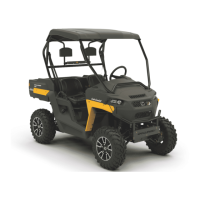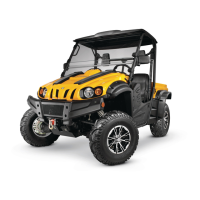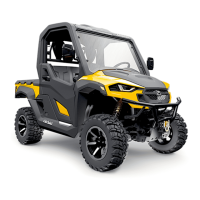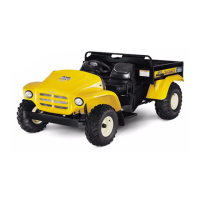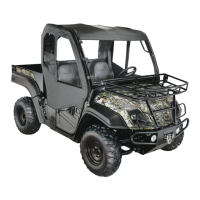11Section 4 — operation
3. For light loads, unlatch cargo bed by pushing
forward on the cargo bed latch lever. While
holding the latch lever forward with one
hand, lift the cargo bed with your other hand.
See Figure 4-5.
Cargo Bed
Latch Lever
Lift Up Cargo Bed
From Here
Figure 4-5
4. Once unloaded, lower bed and securely
latch before operating unit. Do not drive the
vehicle with cargo bed in the raised position.
Towing Loads
WARNING: To help prevent personal
injury due to loss of control or tipping,
always tow a load slow enough to
maintain control.
1. Do not tow a load that exceeds 500 lb (226
kg) rolling weight (i.e. trailer plus cargo) and
never exceed 85 lb (38 kg) tongue weight.
2. Go slow when towing a heavy load. Allow
for increased braking distance. Tow load at a
speed slow enough to maintain control.
3. Do not tow on slopes greater than 5°.
4. Be cautious when towing downhill, even
on a gradual slope or when turning. The
extra weight tends to push the tow vehicle
and may cause you to lose control (braking
and steering ability are reduced; towed
equipment may jack-knife).
IMPORTANT: Extreme angles such as high
railroad crossings can place high bending
loads on hitch connection.
5. Do not modify the hitch in any way.
How to load a Utility Vehicle into a Truck or
onto a Trailer
WARNING: Always park the truck or
trailer in a flat area, set the parking
brake, turn the ignition off and chock
the wheels to prevent any unexpected
movement while loading the utility
vehicle.
WARNING: Fully secure the loading
ramps to the truck or trailer with tie-
down straps or cables to prevent the
ramps from sliding off while loading.
Keep bystanders and/or helpers away
from ramps while loading.
Due to the overall size and dimensions, loading a
utility vehicle into a truck or onto a trailer is a task
that requires precision and the proper equipment to
be achieved safely. By following the steps outlined
below you’ll be able to select the proper equipment
to do the job and safely load and unload your utility
vehicle.
Determine if your truck or trailer is sufficient for
the task
Loading a utility vehicle into a truck or trailer that
can’t support its weight is extremely dangerous. It
is important that before any actual loading is done,
make sure your truck or trailer and loading ramps are
sufficient for loading and hauling the utility vehicle.
Here are some of the variables you need to take into
account:
• Length and width: Measure the size of your
truck or trailer by taking width and length
measurements at the floor level. Compare
these measurements to the width and length
of your utility vehicle to make sure it will fit
comfortably.
• Weight Capacity: Making sure your truck or
trailer can handle the payload of your utility
vehicle is another critical task before any
loading is done. If using a truck, the payload
capacity must be a minimum of ¾ ton. If
hauling on a trailer, remember that the towing
capacity of the vehicle will be reduced by the
added weight of the utility vehicle.
• Tailgate Considerations: If the payload
capacity is sufficient for hauling in a truck, the
last thing left to consider is your truck’s bed
length. Make certain that your truck bed is
long enough to allow the truck’s tailgate to
close completely when the utility vehicle is
loaded into the truck bed.
Choosing the proper loading ramp(s)
Choosing a reliable ramp and understanding how
to properly use it is far and above the best option
for safely loading a utility vehicle into your truck or
onto your trailer. Take a look at the considerations
you should have in mind when choosing the proper
ramp(s):
• Capacity: Utility vehicles are not evenly
balanced, meaning it’s necessary to check the
axle weights before you make any choices
regarding ramps. A typical ramp’s capacity is
based upon two axles with equally distributed
loads. We recommend 3,000-lb minimum
capacity ramp(s) as the appropriate option for
your two-person utility vehicle.
• Offset track widths: Your utility vehicle
has an offset track width front and rear, it’s
important to factor this in to your ramp
placement and ramp width needs. Ramps
need to be wide enough to accommodate the
difference in the distances between the front
two wheels and the rear two wheels.
Raising & Lowering the Tailgate
1. Unlatch the tailgate from cargo bed and
lower. See Figure 4-2 & Figure 4-3.
Figure 4-2
Figure 4-3
2. Raise and relatch the tailgate to the cargo bed.
See Figure 4-3 & Figure 4-4. Do not drive the
vehicle with tailgate in the lowered position.
Figure 4-4
Raising & Lowering Cargo Bed (Dumping
Loads)
WARNING: To prevent the possibility
of bodily injury from unintentional
lowering of the cargo bed, be sure
vehicle is on a level and stable surface
and parking brake is set before raising
cargo bed.
WARNING: A loaded cargo bed can
be very heavy. Do not attempt to
dump a heavily loaded cargo bed.
1. Park the vehicle safely on level ground and set
parking brake.
2. Empty heavy cargo by hand.
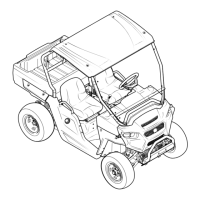
